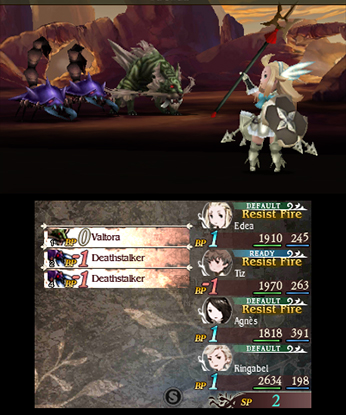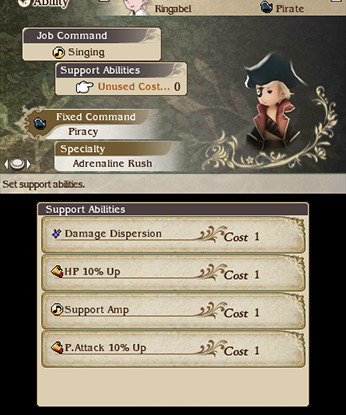Check out our Reviews Vault for past game reviews.
If you hate what Final Fantasy has become, then you’ll love Bravely Default.
Bravely Default is a Japanese role-playing game coming Feb. 7 for the Nintendo 3DS. It doesn’t have a chocobo or moogle in sight, you won’t hear the classic victory fanfare, and the clothing lacks an abundance of zippers.
But make no mistake: This is a Final Fantasy game. In fact, it’s like an alternate reality for the franchise. This is one road the series could have taken before it turned its back on traditional role-playing mechanics and fantasy settings.
Now, I am not someone who thinks that Final Fantasy ruined itself. I actually liked the much-criticized Final Fantasy XIII, and the recent Final Fantasy XIV: A Realm Reborn is currently my favorite massively multiplayer role-playing game. But Bravely Default tops all of them. It not only brings back some of the series’ classic features, like a turn-based battle system and a large overworld filled with towns and dungeons, but also plenty of interesting, new ideas that make it more than a nostalgia act.
What you’ll like
An interesting battle system
Initially, Bravely Default’s battle system looks a lot like the typical, classic JRPG standard. Characters take turns attacking, defending, casting magic, using items, or activating special abilities. But Bravely Default has two major actions, appropriately called Brave and Default, that add a significant layer of depth.
Using Default will increase your defense, but it’ll also stockpile your unused turn (represented as BP). Each character also receives a single point of BP at the start of each new round. Brave lets you use a single BP to add an action to your turn (up to four times). This means that in a single wave you can dish out four attacks, heal your party while also dealing out a little damage, or buff up your entire group with protective magic.
You can also use Brave to put yourself into a bank of negative BP, which is great for dishing out a lot of damage at the beginning of a fight, but it can backfire if you don’t destroy all your enemies and find yourself getting pummeled while you wait to get back into positive BP.
This leads to a lot more strategy then you’d find in more traditional battle systems. Do you want to keep using Default and stock up on BP while defending against stronger attacks, or should you use Brave early and often to attack as soon as you can? It’s a lot more complicated then simply attacking, healing, and exploiting elemental weaknesses, which is what a lot of the classic Final Fantasy games basically boiled down to.
You also have SP (you keeping up with all these acronyms?), which you gain one of for every eight hours the game spends in sleep mode. You can save up to three SP, which you can then exchange to cast an action anytime you want during a battle. That doesn’t sound like a lot, but the ability to act out of turn, even rarely, can have a huge impact. This means that you can heal yourself and save your party from death moments before an enemy delivers a devastating attack. It’s a fail-safe that got me out of a lot of scenarios that would have ended in defeat.
A flexible progression system
As in most JRPGs, your characters grow stronger by earning experience points and leveling up. However, you level each of your character’s classes, called jobs, separately (you earn experience and Job Points at the end of each battle). Earning new job levels unlocks new active and passive abilities (you can only equip so many of the passive ones at a time). You can also switch between jobs at will outside of battle.
Now, the job system is familiar to fans of Final Fantasy. Square has featured it Final Fantasy III, Final Fantasy V, Final Fantasy Tactics, and many others, sometimes under different names. The variation in Bravely Default is most like the one in Final Fantasy V, which was one of my favorite progression systems in any JRPG. You can not only switch easily between classes but also use certain abilities you learned from one job while in the other.
This means that you can have a Black Mage who also knows support magic from the Performer job, or you can have a damage-dealing Pirate who still has all of the defensive bonuses and abilities from the Knight class. It’s an incredible amount of potential customization, especially since Bravely Default has 24 jobs to play with, each with a unique feel and desirable advantages.


